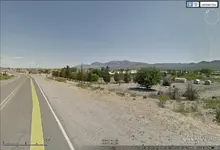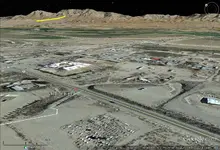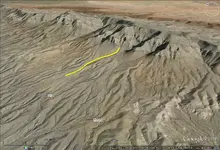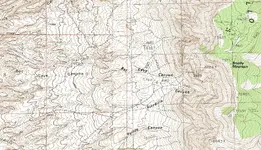... Even if one treasure hunter is relaying what he believes to be good information, does not make it anything other than a pile of BS in and of itself...
... If Phoenician, and this stuff is Ophir related, it was KNOWN that there was such a deposit. ...
... I believe very little of any public information on this stuff, and would not believe, certainly not automatically, MOST private information on it either ...
WHY WAS THERE STILL GOLD THERE IN THE 30's? ...
... Care to expand upon snakes, skeletons, and murders (or booby-trap)? ...
own areas of the two; namely not much north of you and into the REAL gold bearing areas of the West where History tells us the Spanish did not settle.
... All of this Spanish crap and the King's Fifth ...
... What's your theory on where Willie got information and from whom?
Well, you've brought up a boatload of stuff here, all of which probably fits into the North American Unified Treasure Theory - whatever that theory turns out to be, if anyone ever figures it out. This post will touch only on the twentieth century. There's much to be discussed about prior times too.
First ... and foremost: why are we even talking about these things? Because
we've heard stories. Caves of gold bars. Lucky deer hunters. A treasure map is found. A secret document is revealed. Indian attack kills all witnesses of gold deposit or pack train full of loot. Lost Spanish mines. Hidden Jesuit mines. Secret French mining operations. Iron doors in the mountains. Mysterious carvings. Crazed prospector loses a rich ledge of gold. These tales grab your attention. The first thing you might ask is, "If I was ever in possession of true knowledge about any of these types of things, what is the chance that the information would
ever, ever, ever be given to a stranger or end up in the public domain?" Think about it - think about it hard.
For some reason yet to be fully explained, there have been intentional and methodical releases of stories all over the American West, clustered in three general time frames - the 1890's more or less, the 1930's more or less, and around 1980. It's easy to trace the 1890's and 1930's information blitzes. Pick your favorite legend, known or not so well known, and research the details of the story and the time at which it appeared in print. The 1890's bunch generally focused on 'fabulous lost mines innocently lost by the finder' and was revealed through newspapers for the most part. In the 1930's came reports of large caches from the distant past, with secret information revealed to some lucky schmo. These accounts appeared in newspapers again, but to a lesser degree as 'treasure writers' surfaced in magazines and books. You'll find that there is overlapping in story type and actual dates, but the legends likely center around one or more of the scenarios listed in the preceding paragraph. The schmo of course finds the clues he is directed to, but is never able to solve the puzzle, no matter how long he tries. The legacy is a well-known legend and many guys like us willing to pick up the torch and keep looking. [Note: not all treasure legends fit this bill, but the big ones almost exclusively do. There have been plenty of post-hole banks recovered, some outlaw loot found, etc. Most modest recoveries are never publicized.]
I know a few things about the 1980's because I was one of the lucky dupes who received secret information in 1980 about a lost location ('Jerry's lost cave of gold from the 1930's'), knew another lucky dupe who received secret information ca 1978 about another lost location ('the richest gold mine in the world, found by Marcos de Niza'), and more to the point of this thread, a third acquaintance whose uncle found 'Willie's cave in the Caballos' in the 1960's (revealed to him in the 1980's). Information about the first two is available elsewhere. Below is the Caballo story. These are all terrific treasure stories, lapped up by avid pilgrims, but there's an underlying mystery in not only these three instances, but all 'true treasure revelations': who is methodically revealing these tales, and why?
Copy of an email sent by me to a Noss family member ca 2000 (slightly edited for this post):
" ... One of my oldest friends (and a search partner) was a manager at _____ ____ in _____, NM in the early 1980’s and worked with a young metallurgist graduate from east Texas who told him about his mysterious uncle, the black sheep of his family, who revealed a story to the nephew about his own experiences in New Mexico.
The uncle was a prospector/searcher who had been hanging out in T or C for several months in the 1960's. He was exploring in the area around that mine at the end of the dirt road that leads up the mountain from the dam at Caballo Lake (Bat Cave Canyon). I can't remember the mine's name, but I do know the claims were still being kept up in the 1980's because I checked on it myself at the courthouse in T or C as a favor to the nephew. I think the Fingados were involved, also that one-armed private eye from El Paso. A bunch of folks had claims up there - all in the same vicinity. It’s south and below that big open cave you can see from I-25.
The uncle was working a rim rock area and stopped to rest. He noticed a snake hole where he was sitting. He poked it with a rock hammer and the hole started to collapse. He dug out a crawl space into a cave/drift that had been backfilled. Inside he counted about 1200 bars of crude-smelted gold bars (as far as he could see in the darkness), a bunch of skeletons, a big nest of rattlesnakes, and "the smell of death". He tossed out some bars (don't know how many). As he was getting ready to cover up the hole again, two guys came up on him and surprised him. He was armed, so were they. He killed them both and shoved their bodies into the hole, covered it back up and immediately went back to his truck and began driving south. He thought he was being followed, but figured he eluded his chasers in El Paso.
He returned to his home territory in Texas where he bought a big house, closed the shades and stayed drunk for 20 years. None of his family knew where he got his money – they thought maybe he'd robbed a bank or something. The nephew was the only one in the family that the uncle would ever talk to and in the 1980's, when the nephew was in his 20's and was taking a job in New Mexico, the uncle told him the story. He told the kid he would never go back to New Mexico but if the nephew was interested, he'd help him find the cave.
The uncle directed the nephew to drive up the dirt road to the mine and told him to get some photographs of the area. He told him to be sure to take some shots around an old sheave block that was bolted into the side of the hill - it was his landmark.
The nephew went up there with my friend to get the pictures and some guys who were apparently patrolling the road threatened them. The uncle told him ahead of time that they might be hassled - he claimed that the mountain was always being watched through a telescope from a bar in Arrey, I believe. The kid returned to Texas with the photos and the uncle put a pin through one of them and told him that was the spot.
Neither my friend nor I was shown the photo, but the nephew said the pinpoint would never be found unless you knew exactly where to dig - it was well hidden and camouflaged. The nephew was afraid to go up there because of things his uncle told him and also because of the guys who threatened him the day he took the pictures. He took the pictures about 15-18 years ago. I don't know if the uncle is still alive or not. The nephew left the area shortly after all this happened and the last I heard he was working for some big mining company in South America.
If that sheave block is still there, you'll be reasonably close to the hot spot (at least according to the uncle's story). Who knows, maybe the uncle was full of baloney. However, I know that the nephew believed him. I've never been up that road where the kid got his pictures, but I've always been curious about it. To the best of my knowledge, the nephew never showed the picture with the pinhole to anyone or went back up there before he left the country. Bat Cave Canyon is still quite active with mine claimants and treasure hunters."
You asked a very good question earlier - how did Willie get his information? "Why, he happened to find a map" (lucky guy) may float some boats, but not mine. I certainly haven't researched Willie to any great extent, but I'm sure he was a fine fellow and apparently a sincere witness when interviewed as an old man prior to his death. But, back in the thirties, I have to wonder if Willie wasn't an Organization man, playing his part in the game. He seems to have an awfully lot in common with my deceased pal Jerry.




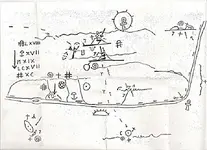
 One of the little things that appeared in the story that interests me even if it possibly isn't true, was the statement, supposly by doc N to her, was that he had to pry the bars apart, and that they didn't look like Gold bars.
One of the little things that appeared in the story that interests me even if it possibly isn't true, was the statement, supposly by doc N to her, was that he had to pry the bars apart, and that they didn't look like Gold bars.  ?
? ,just woke up, when I am refreshed my memory is really good, if theres anything you want to know about the area around caballo's just ask I will
,just woke up, when I am refreshed my memory is really good, if theres anything you want to know about the area around caballo's just ask I will
